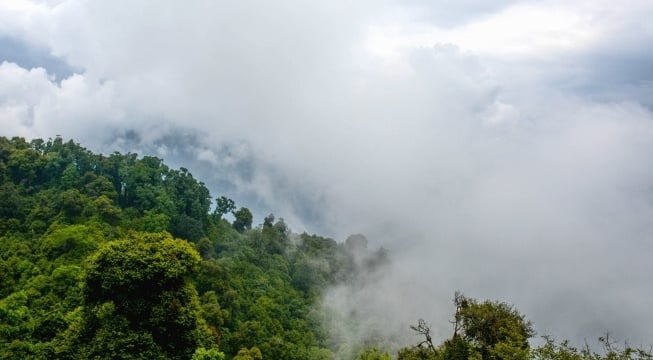
Scientists and environmentalists have lauded the Amazon rainforest since scientific exploration from those outside of the rainforest first began over a hundred years ago, reflecting the region’s unique status on the planet. This unique ecosystem is the world’s largest rainforest and spans some 40% of South America including parts of Brazil, Bolivia, Peru, Ecuador, Colombia, Venezuela, Guyana, and Suriname.
Containing 20% of the world’s flowing freshwater, the Amazon River is the world's largest in terms of discharge—eleven times the volume of the Mississippi River—draining an area equivalent in size to the United States.
The Amazon rainforest covers only 4% of Earth’s surface, yet it is one of the most biodiverse regions on the planet—containing a third of all known terrestrial plant, animal, and insect species. These living organisms are not only inherently valuable simply by adding so much beauty and diversity of life to our world, but they also posses value for humans in the form of food and medicine.
There's also much cultural diversity within the Amazon rainforest. More than 400 different Indigenous groups call this region home—some are isolated tribes who choose to avoid contact with the outside world.
The Critical Role of the Amazon
Covering 6.9 million square kilometers, and containing 10% of all biomass on Earth, the Amazon rainforest acts as a giant sponge, absorbing and storing massive amounts of carbon dioxide while emitting 20% of the Earth’s oxygen. Many scientists point out that because the forest sequesters carbon dioxide while producing oxygen on such a grand scale it “plays a critical role in the global carbon cycle that helps to shape the world's climate,” leading scientists to dub the Amazon as “the lungs of the world.”
A new theory suggests that the value of the rainforest is still widely understated. The latest research proposes that the Amazon is also the beating "heart of the Earth," as millions of trees work together as a kind of “biotic pump” that releases water vapor into the air. This process creates “flying rivers” in the atmosphere that circulate water and weather patterns around the globe.
The Heart of the Earth
Originally conceived in 2007 by Russian scientists Anastassia Makarieva and Victor Gorshkov of the St. Petersburg Nuclear Physics Institute, the biotic pump theory questions the long-standing assumption that rainforests are a consequence of heavy rainfall. The theory contends that instead, some forested regions actually create the conditions necessary that lead to heavy rainfall. Makarieva and Gorshkov assert and claim to have proven that it is “condensation from natural forests” and “not temperature differences, that drive the winds which bring precipitation over land,” a mechanism in which the rainforest itself creates its own rainfall, bringing moisture to all terrestrial life.
The process has many stages beginning with the rainforest drawing water from the ground and releasing the moisture into the atmosphere through the biological process called “transpiration.”
One of the leading climate scientists in Brazil focusing on the biotic pump theory is Dr. Antonio Nobre. Much of his research is on how deforestation of the Amazon rainforest affects global weather patterns, climate, and ultimately, the process of transpiration. In an interview with National Public Radio’s international correspondent Lulu Garcia-Navarro, Nobre explains how the collective efforts of the millions of trees in the rainforest irrigates the atmosphere, creating massive, invisible flying rivers.
As he illustrates, trees are like geysers acting as conduits that pump water vapor up into the sky. “Transpiration is evaporation, but it's evaporation of water that went through the tree,” he says, “so this huge flow of vapor into the atmosphere is like an irrigation [system] upside down.” That creates these immense, invisible flying rivers. Nobre points out that within the Amazon, “20 billion tons of water evaporate per day." To put that number into perspective, it is more water than what the Amazon River discharges into the Atlantic ocean in one day.
Flying Rivers of the Amazon
Forest transpiration is only the first stage of the biotic pump cycle. As Dr. Nobre points out, the model also shows that forests create ocean-to-land winds that pump the moisture laden currents like airborne rivers across the continents. How can forests create these winds?
In 2015, climate change educator, activist, and founding editor of the environmental newsletter The Ecologist, Peter Bunyard, joined Anastassia Makarieva and Victor Gorshkov on an expedition in the Colombian Amazon aiming to prove the biotic pump theory. He shares his experience in his article, Without the Rainforest, the Amazon Will Turn to Desert, explaining that as the large amount of water vapor transpired by rainforests condenses, it lowers area air pressure. Because air flows from places of high pressure to those of low pressure, this decrease in pressure pulls additional dense air in, and so forests draw in moist air from elsewhere (for example, from over the Atlantic Ocean).
This creates a positive feedback loop that “[generates] an implosion of sufficient strength as to suck up air from the surface. That upwards-directed flow...leads to air moving horizontally over the surface to fill the partial vacuum... Hence the idea that the trade winds—skimming over the surface of the Atlantic Ocean on their way from Africa to equatorial South America—are sucked in as a result of cloud formation over the Amazon's rainforests.”
Consequently, as affirmed by the biotic pump theory, the flying rivers of the Amazon carry rainwater in fast moving streams around the Americas. Forests, rather than the ocean, become the low pressure zone where the moist winds converge. Moisture sucked in from the east over the Atlantic merges with the air vapor transpired by the rainforest and continue to travel west, until the current is eventually blocked by the Andes. At this point, the rivers turn south where they continue to release moisture in the form of rainfall as far as Argentina. There are even some reports indicating that these systems influence rainfall as far away as the Western United States and Central America.
Life on Earth Without the Amazon
Bunyard asserts that the biotic pump theory needs to be accepted by the larger scientific and climatological community before it's too late. Most climatologists agree that continued deforestation will lead to a marked decrease in forest transpiration, and therefore rainfall. However, the general belief is that moisture would still be circulated and generated by oceans and the winds they produce.
Bunyard argues that “those models do not include the biotic pump theory of convection and therefore could possibly be dangerously deficient in their analytical predictions of the impacts both of global warming and in particular of deforestation.” He warns that “were the forest to disappear, then according to the theory, moisture would no longer be sucked in and given the natural fall-out rate of rainfall…the land would dry out and in all likelihood turn to desert. Were that the case it would be a disaster of momentous proportions, not just dwarfing the likely changes resulting from global warming but indeed compounding them.”
“If correct, the theory would explain how the deep interiors of forested continents get as much rain as the coast, and how most of Australia turned from forest to desert. It suggests that much of North America could become desert—even without global warming. The idea makes it even more vital that we recognize the crucial role forests play in the well-being of the planet.”
The effects that deforestation of the Amazon is having on rainfall and climate are clearly illustrated in neighboring areas—such as the densely populated central and southern reaches of Brazil—where unprecedented drought has been plaguing the land over the last two years. Calling it “the worst drought in Brazil’s history,” The Guardian reported that in 2015, more than four million people in urban and suburban areas throughout the country have been affected by water rationing and rolling power cuts. “Protesters in dry neighborhoods have taken to the streets, coffee crops have been hit, and businesses forced to close...At least six cities have been hit by blackouts due to weak hydroelectricity generation and high demand for air conditioning as temperatures soar over 35℃. In response, utilities are burning more fossil fuels, adding to the cost of energy and greenhouse gas emissions.” The implications of the report are ominous: drought creates a vicious circle that leads to worsening climate change, that if not addressed and rectified quickly seem to point towards societal collapse.
While some climatologists agree that this disaster is the result of a complex relationship of factors that include global warming and the unchecked growth of cities, they insist that the disruption of Brazil’s weather patterns by the loss of Amazon rainforest is also a contributing factor—and Brazil is not the only country expected to suffer the climatic consequences of this deforestation. One Princeton study suggested that Amazon deforestation could potentially strengthen patterns of extreme drought in places as far away as California, while other research indicates that recent droughts in Texas and New Mexico might be linked to tree cutting in the Amazon. Despite the controversy over the biotic pump theory, it is apparent, as evidenced by these numerous studies, that changing the water cycle in the Amazon would have global consequences not only for human beings but for all life on Earth.
